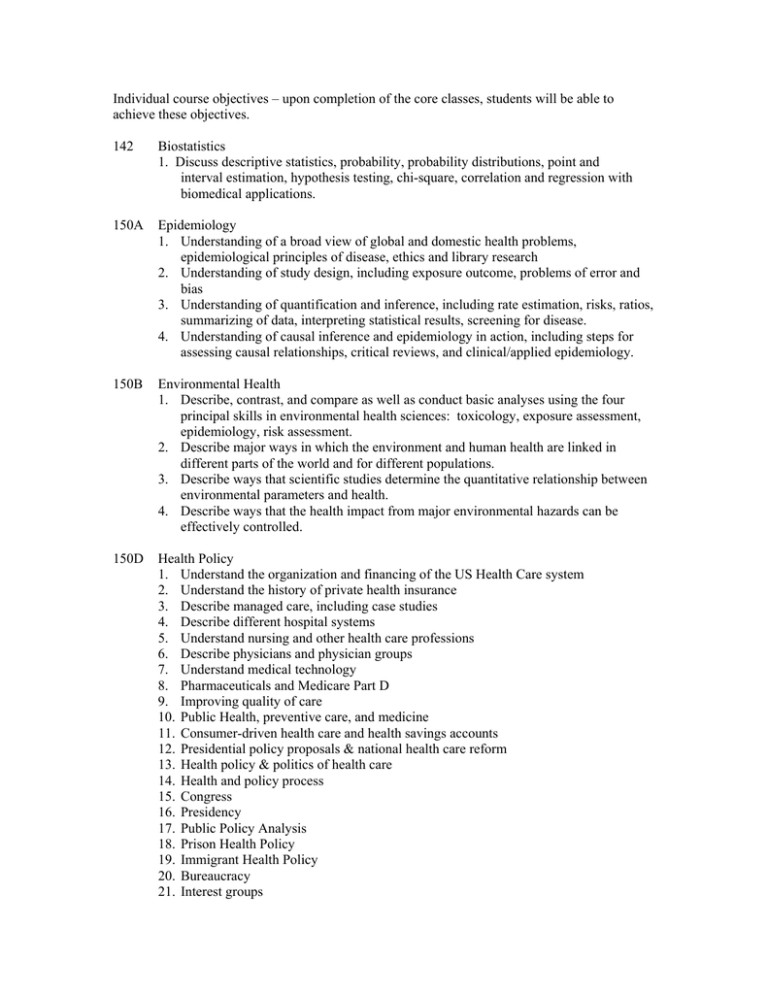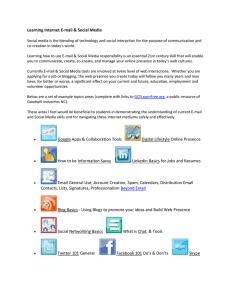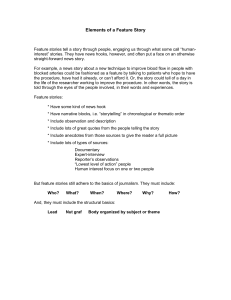Individual course objectives – upon completion of the core classes
advertisement

Individual course objectives – upon completion of the core classes, students will be able to achieve these objectives. 142 Biostatistics 1. Discuss descriptive statistics, probability, probability distributions, point and interval estimation, hypothesis testing, chi-square, correlation and regression with biomedical applications. 150A Epidemiology 1. Understanding of a broad view of global and domestic health problems, epidemiological principles of disease, ethics and library research 2. Understanding of study design, including exposure outcome, problems of error and bias 3. Understanding of quantification and inference, including rate estimation, risks, ratios, summarizing of data, interpreting statistical results, screening for disease. 4. Understanding of causal inference and epidemiology in action, including steps for assessing causal relationships, critical reviews, and clinical/applied epidemiology. 150B Environmental Health 1. Describe, contrast, and compare as well as conduct basic analyses using the four principal skills in environmental health sciences: toxicology, exposure assessment, epidemiology, risk assessment. 2. Describe major ways in which the environment and human health are linked in different parts of the world and for different populations. 3. Describe ways that scientific studies determine the quantitative relationship between environmental parameters and health. 4. Describe ways that the health impact from major environmental hazards can be effectively controlled. 150D Health Policy 1. Understand the organization and financing of the US Health Care system 2. Understand the history of private health insurance 3. Describe managed care, including case studies 4. Describe different hospital systems 5. Understand nursing and other health care professions 6. Describe physicians and physician groups 7. Understand medical technology 8. Pharmaceuticals and Medicare Part D 9. Improving quality of care 10. Public Health, preventive care, and medicine 11. Consumer-driven health care and health savings accounts 12. Presidential policy proposals & national health care reform 13. Health policy & politics of health care 14. Health and policy process 15. Congress 16. Presidency 17. Public Policy Analysis 18. Prison Health Policy 19. Immigrant Health Policy 20. Bureaucracy 21. Interest groups 22. Tobacco policy 23. Bioethics 24. States and health care reform 150E Community Health 1. Describe major social, cultural, and bio-behavioral patterns of health and health behavior in community settings. 2. Describe causes and consequences of leading health behaviors, including tobacco exposure, dietary patterns, physical activity, alcohol consumption, and sexual practices. 3. Describe major public health interventions to improve health in community settings. 4. Describe major theories of health and social behavior, e.g., social learning theory and stages-of-change model, and their application in the conduct of research and practice in public health. 5. Describe basic research from epidemiology and public health on leading health conditions, such as cancer, asthma, obesity, AIDS, and depression. 162A Microbiology 1. Acquire factual knowledge about microbiology. 2. Understand concepts relating to interaction of micro-organisms with their environment, including host-parasite relationship and strategies of intervention to prevent infectious diseases 3. Build a background in microbiology appropriate for entrance into graduate level training in health sciences or basic biological sciences. Learning Goals for Public Health Majors (June 2009) The faculty who teach the Public Health Undergraduate core classes want Public Health majors to have knowledge and skills in the basic principles in the following areas: A) 1. 2. 3. 4. B) 1. 2. 3. 4. 5. 6. C) 1. 2. 3. 4. D) Critical Thinking Skills: Describe the Public Health framework of the determinants of the health of populations. Recognize the Public Health perspective of disease prevention and health promotion. Explain how Public Health studies the interplay between biology, environment, and behavior. Understand the basic concepts from the social and behavioral sciences in Public Health. Quantitative Skills: Recognize commonly used measures of population health. Identify commonly used methods of measuring risk. Describe common study designs for assessing risk from exposures. Assemble and display summary measures using graphs and tables. Recognize the basics of statistical hypothesis testing. Know how to calculate and interpret confidence intervals. Communication Skills: Incorporate statistical and scientific findings into written materials. Prepare fact sheets and other health education tools. Know how to interpret Public Health reports and scientific literature. Create and give presentations on Public Health issues. Problem-Solving Skills: 1. Research and summarize relevant Public Health literature. 2. Apply “systems thinking” approach to issues in Public Health. 3. Identify problems in Public Health with “upstream-downstream” model. E) 1. 2. 3. 4. 5. F) Specialized Knowledge: Integrate human biology and genetics with Public Health issues. Comprehend the basics of infectious disease. Understand the basics of chronic disease. Examine and assess environmental health issues. Describe organization and financing of US health care system. Lifelong Learning Skills: 1. Identify ethical issues of Public Health. 2. Be able to perform data collection and research. 3. Acknowledge the role of disparities in Public Health. Program Level Skills 142 Biostat 150A Epidem. 150B Environ. Health 150D Health Policy 150E Community Health 162A Microbio Electives Critical Thinking Describe the P.H. framework: determinants of the health of populations Recognize the P.H. perspective: disease prevention and health promotion Explain how P.H. studies the interplay between biology, environment, and behavior Understand the basic concepts from the social and behavioral factors used in P.H. X X X X X X X X X X X Quantitative Skills Recognize commonly used measures of population health Identify commonly used methods of measuring risk associated with exposures Describe common study designs for assessing risk Assemble and display summary measures using graphs and tables Recognize the basics of statistical hypothesis testing Know how to calculate and interpret confidence intervals X X X X X X X X X X X X X X X Communication Skills Incorporate statistical and scientific findings into written materials Prepare fact sheets and other health education tools Know how to interpret P.H. reports and scientific literature Create and give presentations on Public Health issues X X X X X X X X X X X X X X X X X Problem Solving Skills Research and summarize relevant P.H. literature Apply “systems thinking” approach Identify problems using “upstream-downstream” model X X X Specialized Knowledge Integrate human biology and genetics with Public Health issues X X X Comprehend the basics of infectious disease Understand the basics of chronic disease Examine and assess environmental health issues Describe organization and financing of US health care system X X X X X Lifelong Learning Skills Identify P.H. ethical issues Be able to perform data collection and research Acknowledge the role of disparities in Public Health X X X X X X X Assessment/Evaluation of Learning Goals In Fall of 2009, the Undergraduate Management Committee faculty (those who teach the core courses) will meet to discuss the learning goals and the mapping of these goals to the topics taught in their courses. These goals will be made explicit in the course objectives for each course, and instructors will cover learning goals in the exams. Additionally, data and information from the exit surveys for the individual core courses as well as the exit survey for the entire program prior to graduation will be used to assess and evaluate learning goal achievement.




